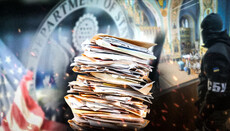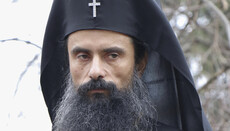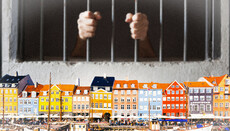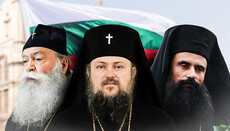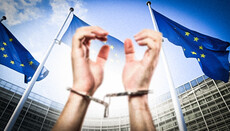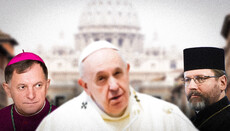Schism and profession of faith: Drama of Ukrainian Orthodoxy in full
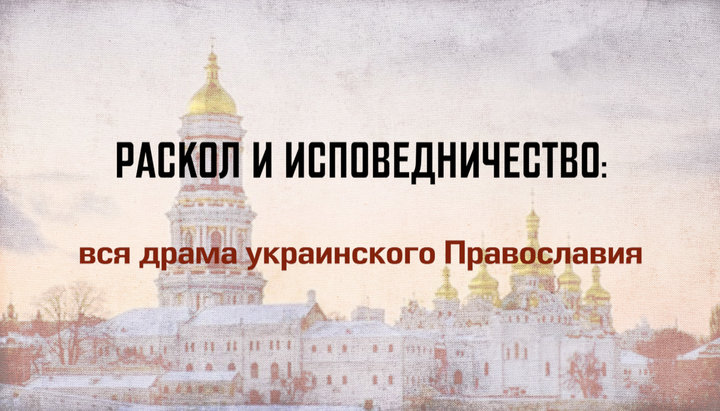
Chronology of the Ukrainian schism from the rise of the UOC-KP to its legalization by Phanar. Why the true Church is only growing despite all the efforts of politicians.
The sunset of the Soviet era directly reflected on the position of the Church, including in Ukraine. On the one hand, it was a time of the revival of faith and mass construction of temples, but on the other hand, it was the surge of nationalism in the West of the country and large-scale seizures of temples by Uniates and dissendents-autocephalists.
Filaret Denisenko, who for many years had been the rightful metropolitan and head of the Ukrainian Exarchate of the Russian Orthodox Church, reviled the seizures and gracelessness of the hierarchy of the autocephalous Church.
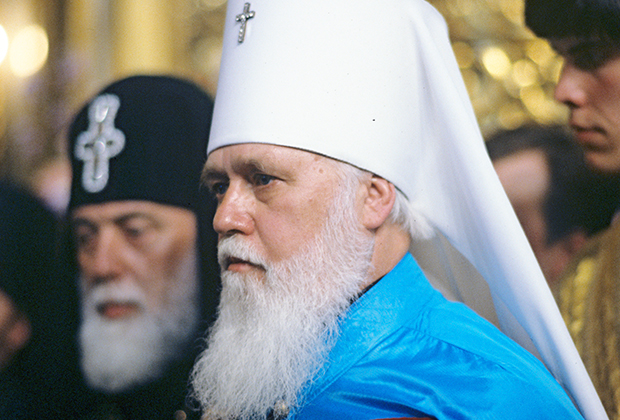
In particular, on November 4, 1990, at a sermon at the Florovsky Monastery in Kiev, he claimed: “... autocephalists cannot grant absolution. Because a layman cannot do this but only a priest or a bishop. The Sacrament of the Holy Communion is also invalid. This is not the Body and Blood of the Savior but ordinary bread and wine. And therefore, no one should be tempted by this autocephaly. In general, this Church was not created to save human souls but in order to fight, to be a political tool against Moscow. That's why they need this autocephalization of the church!”
In 1990, Russian Patriarch Pimen died, and the election of the new Primate was held. Filaret was among the contenders and hoped to win with the help of the Communists, but in the end he ranked only third.
Then he demanded the status of full autocephaly for the UOC, hoping to lead, if not Russian, then at least the Ukrainian Church, which in 1990 received a letter missive from the Russian Orthodox Church. It prescribed that from now on this Church receives the broad powers of autonomy and full administrative independence.
Being at St. Sophia Cathedral of Kiev, Alexy II, Patriarch of the Russian Orthodox Church said:
“We, the humble Alexy II, by the grace of God, the Patriarch of Moscow and All Rus, bless through the present letter with the power of the All-Holy Spirit to be henceforth an independent and self-governing Ukrainian Church.”
In November 1991, the UOC Council was convened, where Filaret forced all the bishops of the UOC to sign a petition for autocephaly. However, the Orthodox people of Ukraine were not ready to break the prayer relationship with the Russian Church and did not accept the idea of full autocephaly. Therefore, a lot of hierarchs, including the current Primate, His Beatitude Onuphry, withdrew their signatures. Then Filaret removed them from their Episcopal sees.
In 1992, at the Bishops' Council of the Russian Orthodox Church in the Danilov Monastery, most of the hierarchs of Ukraine expressed their distrust of Filaret. He was accused of dictatorship and rigorous administration of the Church, as well as an immoral lifestyle, since the monk is forbidden to have a wife and children. Filaret before the cross gave the bishop's word to resign:
“It is said in the Gospel: ’Rather, let your words be ‘Yes’ and ‘No’; anything more than that comes from evil’. If I said that I will do it, then I will. I will submit a petition to the Bishops' Council of the Ukrainian Orthodox Church that I ask you to take these powers and the rights of the Primate of the UOC from me and to elect a new Primate for this position."
However, Filaret did not keep his word and upon his return said, “Remember – I won’t leave anywhere!” As a result, the general decision of the UOC bishops at the Kharkov Council removed Filaret and Metropolitan Vladimir (Sabodan) became the new Primate.
However, Filaret did not put up with this situation. With the help of President Kravchuk and the deputies, he decided to enter into an alliance with those whom he used to hate and convict yesterday – nationalists and autocephalists. This is how the UOC of the Kiev Patriarchate emerged.
Out of the entire Ukrainian Orthodox Church, only two bishops backslid into schism following Filaret. On the contrary, Metropolitan Vladimir, who became the Primate of the UOC instead of Filaret, was met at the train station in Kiev by tens of thousands of people.
Metropolitan Agaphangel, ruling bishop of the Odessa Eparchy of the UOC:
“Tens of thousands of people met His Beatitude upon his leaving the carriage, and sang in glee ‘Christ is risen!’ With tears in their eyes, people came up, bowed, spread their clothes on the ground to make a path. A lot of clergy had arrived from all the dioceses. As many as 5 buses arrived only from the Vinnitsa eparchy.”
After creating the schism, Filaret’s rhetoric changed dramatically from pro-communist to nationalist. He began to extol everything he used to criticize fiercely.
For disobedience to the Church, Filaret was defrocked in 1992. In 1997, he was excommunicated and anathematized for his schismatic activities.
The punishments for Filaret were recognized by absolutely all Local Churches, and first of all – by Constantinople. In 1992, Patriarch Bartholomew sent a letter to Patriarch Alexy stating the decision on Filaret: "Our Holy Great Church of Christ, recognizing the full and exclusive competence of your Most Holy Russian Church in this matter, synodically accepts the decision on the above.”
In 1997, Patriarch Bartholomew wrote to the Primate of the Russian Church: “Having received the notice about this decision, we have informed the hierarchy of our Ecumenical See about it and asked them henceforth to have no church communion with the these persons.”
All Filaret’s letters to Phanar with an appeal and a request to take him under its wing remained unanswered. Constantinople recognized the Metropolitan of Kiev – the head of the Ukrainian Orthodox Church – as the canonical first hierarch in Ukraine.
In 2008, when Ukraine celebrated the anniversary of the 1020th anniversary of the Baptism of Russia, Patriarch Bartholomew served in Kiev with Patriarch Alexy of the Russian Church, head of the UOC His Beatitude Vladimir and other Russian and Ukrainian hierarchs.
In 2016, in Chambesy, at the Synaxis of Primates of the Local Orthodox Churches, Patriarch Bartholomew called His Beatitude Onuphry the only canonical first hierarch in Ukraine.
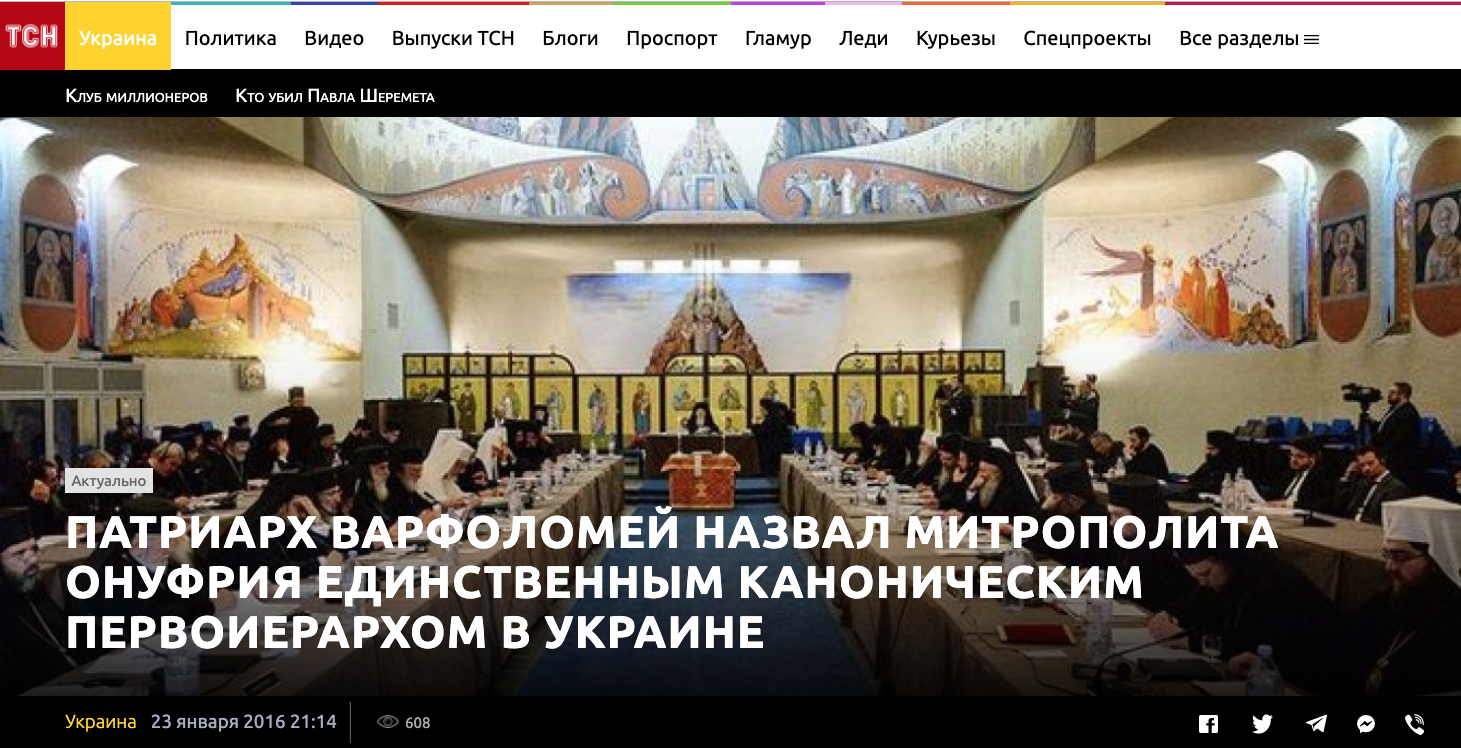
But only a few years passed, and the Euromaidan took place in Ukraine. The pro-nationalist forces came to power, who headed for the support of schismatics and the destruction of the canonical Church.
In 2016, when the Ukrainian Orthodox Church organized a large-scale All-Ukrainian Cross Procession with a prayer for peace from the Pochaev and Sviatogorsk Lavras to the Kiev Pechersk Caves Lavra, nationalists blocked the procession, mined roads and staged provocations against the participants in the procession. When the procession was approaching Boryspil with the Sviatogorsk Icon of the Most Holy Theotokos, only the intervention of the police saved the believers from massacre. Nationalists, who could not reach the believers, began to throw eggs at the icon. The priest had to take off his vestments and shield an image with them.
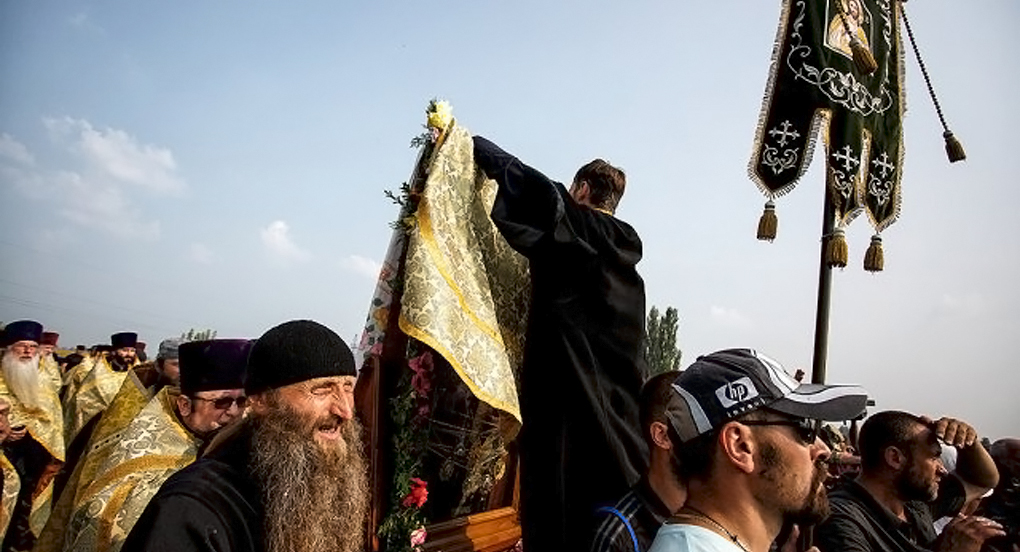
President Poroshenko, who for many years was a parishioner of the canonical Ukrainian Orthodox Church, changed dramatically his attitude towards the UOC towards the end of his cadence and upcoming new presidential elections and chose to rely on nationalists.
He began to take the Holy Communion from the Greek Catholics and then took several steps to create a new Church. His political technologists did not hide the fact that the project of the new religious structure was just a political election tool.
Taras Berezovets, political strategist of the team Petro Poroshenko:
“We can say that this is a standard election technology. And this will be right, because 36% of the population support the One Local Church in Ukraine.”
Poroshenko himself put the issue of the new Church on a par with political projects, which, in his opinion, were to ensure his victory in the elections:
“For me, the affirmation of the Local Church is a matter of the same importance as a visa-free regime, an Association Agreement with the European Union, as well as our common struggle for membership in the European Union and NATO, which we still have ahead.”
In 2016, the Verkhovna Rada voted in favor of the bill “On the Petition of the Verkhovna Rada of Ukraine to His Holiness Bartholomew, Archbishop of Constantinople and New Rome, Ecumenical Patriarch on granting autocephaly to the Orthodox Church in Ukraine”.
Let's recall once more who the initiators of the appeal are. Parliamentarians: Paruby, Vysotsky, Levus, Knyazhitsky, Matios, Yelensky, Demchak. Almost all of the authors of the petition are Greek Catholics and have absolutely nothing to do with Orthodoxy.
In April 2018, after his “journey” to Phanar, Poroshenko announced that he had agreed with Patriarch Bartholomew on the creation of a new Church.
Poroshenko subjected the hierarchs of the canonical Church to severe pressure to force them to unite with schismatics under the leadership of Phanar. The bishops were summoned to the Security Service of Ukraine for interviews and interrogations, corrupt "activists" were sent under the diocesan administration, who shouted threats and insults:
"Ukraine above all! Communist priests should be hanged like Moskals!".
The Ukrainian media ventilated provocations that many bishops were reportedly ready to unite with schismatics from the Kiev Patriarchate and UAOC.
However, on December 15, 2018, when the so-called “Unification Council” began in St. Sophia Cathedral of Kiev, out of 97 bishops of the Ukrainian Orthodox Church, only two appeared. And only one of them, Simeon Shostatsky, was the ruling bishop from Vinnitsa, a close friend of Poroshenko, whom the then president had promised the post of Primate of the new structure.
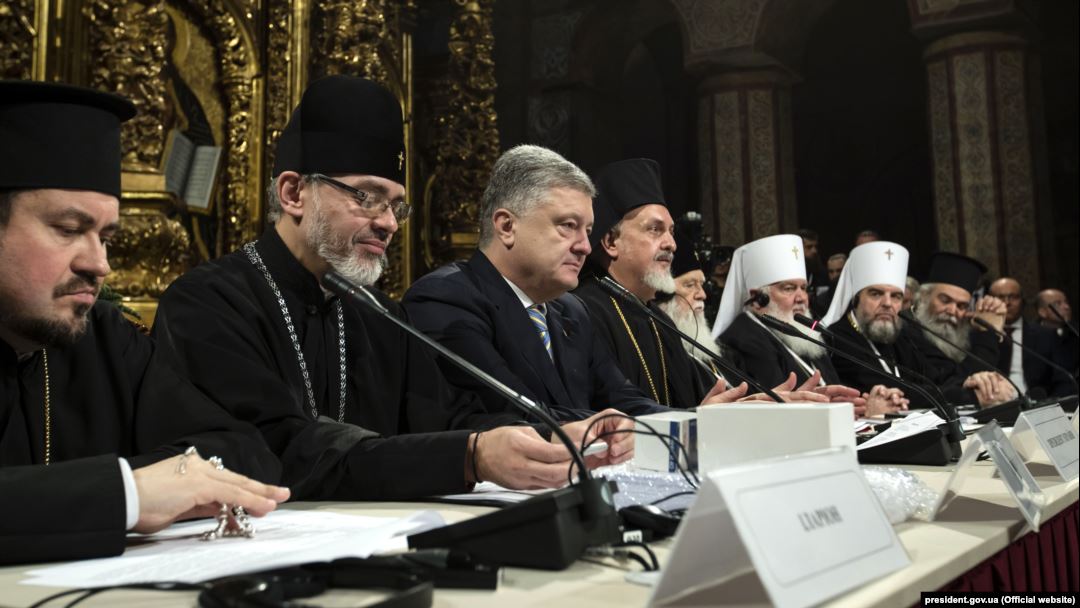
All statements of both Phanar and former President Poroshenko on the unification of TOTAL Ukrainian Orthodoxy turned out to be a lie – no unification occurred even between the schismatics from the Kiev Patriarchate and the UAOC. In the new structure, each city ended up with having two dioceses of the OCU and two ruling bishops; in Vinnitsa, where Simeon Shostatsky comes from, there being three of them.
The canonical Ukrainian Orthodox Church has not changed in any way; it is still twice as big by the number of parishes of schismatics, while by the number of monasteries and monks – tenfold. However, Poroshenko in the last months of his reign gave the command to forcible "integration" into the new structure.
In the villages, local authorities received a command to hold meetings of all the village residents under the guise of a church community meeting and transfer them to the OCU.
As a result, the church community would gather in the church and resolve to stay in the canonical Church, while the community of the village, in which there were Uniates, Protestants, and atheists would also gather at the club and decide to forcibly transfer the temple to the OCU.
With the help of the police and radicals, churches were seized; the locks were cut down by a grinder, a chainsaw, or broken with crowbars. Believers of the UOC were expelled from their temples by force, many people were injured in collisions.
Due to the raid attacks, dozens of parishes have to pray now in private homes, barns, garages, or simply under a canopy.
While the canonical Church maintained its unity under tremendous pressure from the authorities, the newly formed structure split. Filaret Denisenko with several bishops left the OCU and began to lead the Kiev Patriarchate. In relation to Epiphany Dumenko, Filaret stated that albeit he was under anathema, Epiphany and other members of the OCU are not even priests:
“Even if I was anathematized, it means that all these hierarchs (OCU – Ed.) are invalid. And Epiphany is not only a metropolitan – he is not even a priest."
***
From the first steps of creating the OCU, Epiphany and the head of the Ukrainian Uniates Sviatoslav Shevchuk developed a cooperation map. Epiphany Dumenko told reporters that the key to the unity of the OCU and the Uniates lies in Rome and Constantinople.
On September 22, 2019 in Vinnitsa, three bishops of the OCU, including Simeon Shostatsky, took part in a joint procession with Catholics and Uniates.
On October 14, in the city of Varash, Catholic priest Vasily Plahotka prayed with Epiphany Dumenko and other members of the Orthodox Church in the altar of an Orthodox church.
On November 4, in the village of Germakovka, Ternopil Region, the rector of the local OCU temple, Vladimir Stefanko, prayed at the festive service of the UGCC together with the Uniate bishop Dmitry Grigorak and Greek Catholic clergy.
At the same time, the canonical Ukrainian Orthodox Church every year is gaining more and more support from the Ukrainian people. The attacks and pressure of the authorities, their obvious support for the schismatics, give opposite results. Even more people are turning to the canonical Church. Communities, whose temples were taken away from them, are building new ones.
Whereas in 2018, 250,000 believers participated in the cross procession in Kiev, dedicated to the Baptism of Rus Feast, in 2019 there were already 300,000. A huge credit should be given to the Primate of the UOC, His Beatitude Onuphry. He does not make political statements, nor does he condemn anyone, he only speaks about faith and salvation.
Thus, one can safely say that despite all the Tomos-driven storms, despite Phanar pushing through the recognition of the OCU in the Greek Churches, the Ukrainian Orthodox Church continues its development with the Ukrainian people coming along with their Church and Her Primate.
